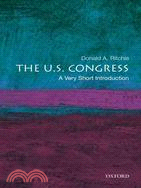目前查詢
歷史查詢

The U.S. Congress :a very short introduction /
- 館藏(1)
- 書目資訊
- 心得(0)
- 機讀格式
- 標籤
書名 : The U.S. Congress :a very short introduction /
紀錄類型 : 書目-語言資料,印刷品: 單行本
正題名[資料類型標示]/作者 : The U.S. Congress :Donald A. Ritchie.
其他題名 : a very short introduction /
其他題名 : United States Congress.
作者 : Ritchie, Donald A.,
出版者 : New York :Oxford University Press,c2010.
面頁冊數 : xvii, 146 p. :ill. ;18 cm.
內容註 : Machine generated contents note: -- Preface -- Chapter 1: The Great Compromise -- -Why Not a Parliament? -All Laws Necessary and Proper -The People's House -The Cooling Senate -To Get Along, Go Along -- Chapter 2: Campaigns andConstituents -- -Campaigning for Congress -The Freshman Class -Serving Constituents -Media Relations and News Coverage -- Chapter 3: Congress at Work -- -The Committees-Turning Bills into Laws -House Committees -Senate Committees -Appropriations: Where Things Happen -- Chapter4: Floor Proceedings and Coalition Building -- -Debate, Rules, and Procedure -Majority Rule in the House -MinorityMuscle in the Senate -Making Laws and Making Sausage -- Chapter 5: Checks and Balances -- -The Chief Legislator -Advice and Consent -War and Peace -Congress Investigates -Punishment and Protection -Congress and the Courts -- Chapter 6: The Contours of Capitol Hill -- -The Capitol -The Members -The Staff -Lobbyists and Other Visitors -- Bibliography -- Notes -- Index.
ISBN : 9780195338317 (pbk.) :
集叢項 : Very short introductions ;244.
LEADER 05061nam 2200217 a 4500
001 295861
003 TNML
005 20131113103333.0
008 180321s2010 nyua b 001 0 eng
020 $a9780195338317 (pbk.) :$cNT$480$
035 $a783920
040 $aDLC$cDLC$dYDX$dBTCTA$dYDXCP$dUKM$dBIB$dCDX$dBWX$dABG$dVP@$dUtOrBLW
082 00$a328.73$222
100 1 $aRitchie, Donald A.,$d1945- .
245 14$aThe U.S. Congress :$ba very short introduction /$cDonald A. Ritchie.
246 3 $aUnited States Congress.
260 $aNew York :$bOxford University Press,$cc2010.
300 $axvii, 146 p. :$bill. ;$c18 cm.
490 1 $aVery short introductions ;$v244.
504 $aIncludes bibliographical references and index.
505 8 $aMachine generated contents note: -- Preface -- Chapter 1: The Great Compromise -- -Why Not a Parliament? -All Laws Necessary and Proper -The People's House -The Cooling Senate -To Get Along, Go Along -- Chapter 2: Campaigns andConstituents -- -Campaigning for Congress -The Freshman Class -Serving Constituents -Media Relations and News Coverage -- Chapter 3: Congress at Work -- -The Committees-Turning Bills into Laws -House Committees -Senate Committees -Appropriations: Where Things Happen -- Chapter4: Floor Proceedings and Coalition Building -- -Debate, Rules, and Procedure -Majority Rule in the House -MinorityMuscle in the Senate -Making Laws and Making Sausage -- Chapter 5: Checks and Balances -- -The Chief Legislator -Advice and Consent -War and Peace -Congress Investigates -Punishment and Protection -Congress and the Courts -- Chapter 6: The Contours of Capitol Hill -- -The Capitol -The Members -The Staff -Lobbyists and Other Visitors -- Bibliography -- Notes -- Index.
520 $a"Many scholars believe that the framers of the Constitution intended Congress to be the preeminent branchof government. Indeed, no other legislature in the world approaches its power. Yet most Americans have only a murkyidea of how it works. In The U.S. Congress, Donald A. Ritchie, a congressional historian for more than thirty years, takes readers on a fascinating, behind-the-scenes tour of Capitol Hill--pointing out the key players, explaining their behavior, and translating parliamentary language into plain English. No mere civics lesson, this eye-opening book provides an insider's perspective on Congress, matched with a professional historian's analytical insight. After a swift survey of the creation of Congress by the constitutional convention, he begins tounscrew the nuts and pull out the bolts. What is it like to campaign for congress? To attract large donors? To enter either house with no seniority? He answers these questions and more, explaining committee assignments (and committee work), the role of staffers and lobbyists, floorproceedings, parliamentary rules, and coalition building. Ritchie explores the great effort put into constituent service--as representatives and senators respond to requests from groups and individuals--as well as media relations and news coverage. He also explores how the grand concepts we all know from civics class--checks and balances, advise and consent, congressional oversight--work in practice, in an age of strong presidents and a muscular Senate minority (no matter which party is in thatposition). In this sparkling addition to Oxford's Very Short Introduction series, Donald Ritchie moves beyond the cynicism and the platitudes to provide a gem ofa portrait of how Congress really works"--$cProvided by publisher.
520 $a"Congress is the most open branch of the federal government, and its members labor to provide constituent services and court the news media, but because they speak with many voices they have long operated at a disadvantageagainst the singular image of the president. This very short introduction to Congress offers a concise explanation of how the Congress operates and provides historical context for its evolution. As a national forum,congressional debates and compromises have sought not onlyto enact laws but to forge national consensus behind them.Congress writes all federal laws, appropriates all federalfunds, and checks and balances the executive and judicial branches. Its constitutional powers, structures, and procedures have remained remarkably consistent for more than two centuries. Yet Congress has often been criticizedfor obstructing or not standing up to the presidency, and for neglecting or delaying pressing national needs. This short introduction highlights the rules, precedents, and practices of the Senate and House of Representatives. It offers glimpses into their committees and floor proceedings to reveal the complex processes in which they enact legislation. It considers how members are elected and reelected, and the role of campaigns, lobbying, staff,and the media in legislative business. It also examines the changing demography of Congress, with the election of more women and racial and ethnic minorities, and their impact on the legislative process, in an era when a woman serves as Speaker of the House and African Americans chairkey committees"--$cProvided by publisher.
610 10$aUnited States.$bCongress.
830 0$aVery short introductions ;$v244.
